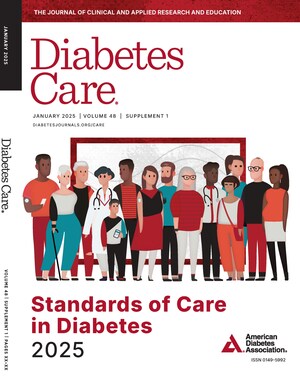Access to Continuous Glucose Monitors in Pediatric Diabetes Populations Improves Glycemic Control, Reduces Hypoglycemia and Improves Satisfaction with Diabetes Care and Technology Use
Studies examining effectiveness of CGM among children, teens and young adults with type 1 diabetes presented at the ADA's Scientific Sessions
SAN FRANCISCO, June 10, 2019 /PRNewswire/ -- Diabetes requires management 24 hours a day, seven days a week, 365 days of the year and presents numerous daily challenges, particularly for families of young children and for adolescents and young adults with type 1 diabetes (T1D). Continuous glucose monitors (CGMs) can help young persons and families monitor glucose levels in real time, alerting them to a possible need for treatment adjustments. Today, two studies about the use of CGMs in pediatric and young adult populations were presented in the "Joint ADA/JDRF Symposium – Continuous Glucose Monitoring in Pediatric Diabetes — Ready for Prime Time?" at the American Diabetes Association's (ADA) 79th Scientific Sessions® at the Moscone Convention Center in San Francisco.
Currently, approximately 1.25 million Americans are living with T1D, the most common form of diabetes among children. T1D results when the pancreas fails to produce insulin, a hormone necessary to convert food into energy that fuels the body. Without insulin, other organs in the body struggle to function properly, which leads to serious complications. Glucose can accumulate in the blood, causing hyperglycemia (high blood sugar), or glucose levels can fall, leading to hypoglycemia (low blood sugar). Both hyper and hypoglycemia can lead to emergency room treatment, hospitalization, and if not treated, can cause long-term health complications including death. Technologic advances of CGMs provide vital information that can improve daily diabetes management and, ultimately, better long-term health outcomes.
Strategies to Enhance New Continuous Glucose Monitoring Use in Early Childhood (SENCE)—Primary Study Results
Managing low blood sugar levels is of great importance in pediatric T1D care. However, when children have blood sugar levels above the target range, it can have negative effects on brain structure and function. Researchers conducted the six-month SENCE study to assess if CGM use by itself or coupled with a family behavioral intervention (FBI) increased the amount of time children with T1D maintained blood sugar levels in range, as recommended by ADA's Standards of Medical Care in Diabetes.
The study enrolled 143 children at 14 sites across the United States ages 2 to 7 years who had not previously used a CGM to manage their diabetes. Patients were randomly divided into three study arms—one-third of participants used self-monitoring of blood glucose using a glucose meter with test strips, one-third used CGM, and one-third used CGM and were provided five 30-minute educational FBI sessions. Sessions were delivered at clinical visits, staggered between one and 19 weeks after CGM started.
At baseline, all participants spent about 40% of their time in a target range of 70-180 mg/dl and about 55% of their time above this range. After reviewing participants' time-in-target range across the entire study period, researchers did not find a change or difference among the three groups. However, the CGM + FBI group improved time-in-range when compared from enrollment to the end of the study, which allowed all five behavioral intervention sessions to be delivered. Using CGM, children spent less time with glucose values less than 70 mg/dl and over 300 mg/dl, had less variable blood sugar levels and experienced fewer severe low blood sugar events. At the 26-week follow up, the CGM + FBI group reported feeling less burdened by their diabetes care, worrying less about hypoglycemia and had greater satisfaction with diabetes technology use compared to the other two groups. Children had excellent compliance, with 90% of children wearing CGM more than six days per week at study end.
"While we were surprised our participants' time-in-target range did not improve with CGM use, we were enthusiastic to see we moved the needle on time spent with low blood sugar, severe low blood sugar events and very high levels," said Linda Anne DiMeglio, MD, MPH, professor of pediatrics at Indiana University School of Medicine and assistant director of Clinical and Translational Research at the Wells Center for Pediatric Research. "Furthermore, we were encouraged to learn with advances in technology and caregiver support, caregivers for very young children with diabetes are able to improve outcomes for their children. We hope this data will help inform policies in states where CGMs are not covered by insurers including Medicaid, so children can have access and coverage to CGMs to maintain healthy glucose levels."
CGM Intervention in Teens and Young Adults With Type 1 Diabetes (CITY)
Although use of CGM in clinical practice has drastically increased over the past five to six years, only about 25% of adolescents and young adults are using CGM according to data from the T1D Exchange Clinic Registry of individuals with T1D. Registry data have also shown that teens and young adults as an age group have the poorest glucose control, with modest numbers, fewer than one-fifth, meeting the ADA clinical targets for A1c.
A continuous glucose monitor measures blood glucose approximately every five minutes and allows for the glucose levels to be viewed on a display device or smartphone application. A CGM can be used to replace self-monitoring of blood glucose, which involves a finger stick each time blood glucose is checked.
The CITY study evaluated the impact of CGM on diabetes management in adolescents and young adults with T1D with suboptimal glucose levels. The study enrolled 153 participants ages 14 to 24 with T1D duration 12 months or longer. They were randomly assigned to either a Dexcom CGM device or self-monitoring of blood glucose. The study's primary outcome assessment was the participants' A1C levels after six months.
Reductions in hemoglobin A1c and reductions in the amount of time blood glucose values were in a high (hyperglycemia) range and low (hypoglycemia) range were observed. Approximately 70% of CGM group participants wore the device an average of five or more days per week, with less than 10% no longer using the device at six months. There were no safety concerns for either treatment group. In addition to the improved glycemic outcomes, patient reported glucose monitoring satisfaction was higher among CGM users compared with those using a blood glucose meter.
"Adolescents and young adults have been shown to have very poor glucose control and often struggle to adhere to the recommendations of health care providers," said lead study author Lori M. Laffel, MD, MPH, chief of the Pediatric, Adolescent and Young Adult Section, and senior investigator and head of the section on Clinical, Behavioral and Outcomes Research at Joslin Diabetes Center, and professor of pediatrics at Harvard Medical School. "Results from the CITY study show adolescents and young adults are willing to wear the CGM device and that use of the device improves glucose levels. Knowledge from our study may help to increase the number of adolescents and young adults who use CGM and the results may also help pave the way for the successful uptake of future automated insulin delivery systems for this vulnerable group of teens and young adults in need of improved glucose control."
To speak with Dr. DiMeglio or Dr. Laffel, please contact the ADA Press Office on-site at San Francisco's Moscone Convention Center on June 7-11, by phone at 415-978-3606 or by email at [email protected].
The American Diabetes Association's 79th Scientific Sessions, the world's largest scientific meeting focused on diabetes research, prevention and care, is being held June 7-11, 2019, at the Moscone Center in San Francisco, California. Nearly 15,000 leading physicians, scientists, health care professionals and industry representatives from around the world have convened at the Scientific Sessions to unveil cutting-edge research, treatment recommendations and advances toward a cure for diabetes. During the five-day meeting, attendees receive exclusive access to more than 850 presentations and 2,000 original research presentations, participate in provocative and engaging exchanges with leading diabetes experts, and can earn Continuing Medical Education (CME) or Continuing Education (CE) credits for educational sessions. The program is grouped into eight thematic areas: Acute and Chronic Complications; Behavioral Medicine, Clinical Nutrition, Education and Exercise; Clinical Diabetes/Therapeutics; Epidemiology/Genetics; Immunology/Transplantation; Insulin Action/Molecular Metabolism; Integrated Physiology/Obesity; and Islet Biology/Insulin Secretion. Gretchen Youssef, MS, RDN, CDE, President of Health Care and Education, delivered her address, "It's All About Access!," on Saturday, June 8, and Louis H. Philipson, MD, PhD, FACP, President of Medicine and Science, delivered his lecture, "Precision Medicine—Addressing the Many Faces of Diabetes," on Sunday, June 9. Join the Scientific Sessions conversation on social media using #ADA2019.
About the American Diabetes Association
Every day more than 4,000 people are newly diagnosed with diabetes in America. Nearly 115 million Americans have diabetes or prediabetes and are striving to manage their lives while living with the disease. The American Diabetes Association (ADA) is the nation's leading voluntary health organization fighting to bend the curve on the diabetes epidemic and help people living with diabetes thrive. For nearly 80 years the ADA has been driving discovery and research to treat, manage and prevent diabetes, while working relentlessly for a cure. We help people with diabetes thrive by fighting for their rights and developing programs, advocacy and education designed to improve their quality of life. Diabetes has brought us together. What we do next will make us Connected for Life. To learn more or to get involved, visit us at diabetes.org or call 1-800-DIABETES (1-800-342-2383). Information is available in English and Spanish. Join the fight with us on Facebook (American Diabetes Association), Twitter (@AmDiabetesAssn) and Instagram (@AmDiabetesAssn).
Contact: |
|
Press Office in San Francisco |
Michelle Kirkwood |
June 7-11, 2019 |
(703) 299-2053 |
415-978-3606 |
SOURCE American Diabetes Association

Related Links
WANT YOUR COMPANY'S NEWS FEATURED ON PRNEWSWIRE.COM?
Newsrooms &
Influencers
Digital Media
Outlets
Journalists
Opted In






Share this article